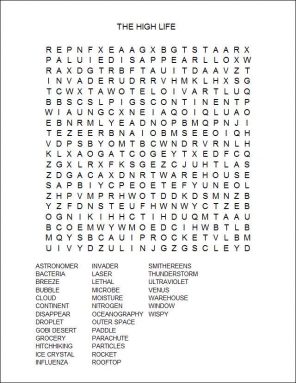The high life
The sky is full of microscopic life, some of which might even trigger rain or snow
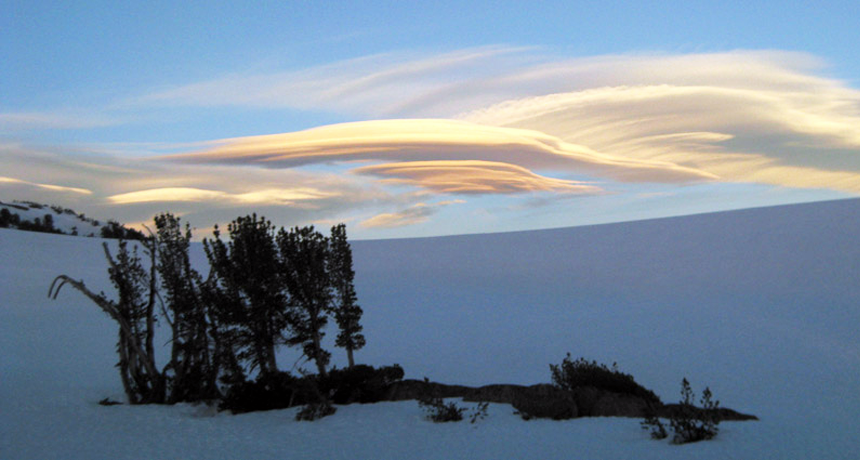
Clouds are full of living microscopic organisms, not just bits of dust and soot. Some scientists believe that germs living inside clouds might sometimes trigger rain or snow.
Douglas Fox
By Douglas Fox
The alien invaders arrived quietly. Only one man noticed as they drifted down from the sky.
Donald Barber was an astronomer at Norman Lockyer Observatory. Its telescopes sat on a grassy hill surrounded by farmland on the south coast of England. Barber was using the telescopes to measure the light from far-off stars. He captured the starlight in photographs produced on glass plates coated with chemicals, like the film in an old camera. It was only after Barber developed those photographic plates in the summer of 1937 that the first signs of tiny alien invaders emerged.
As Barber developed his photographs, he found they were ruined. Thousands of strange black dots covered the images. Barber looked at the glass plates through a microscope and discovered the culprit: At the center of each black dot was a tiny island of life, a clump of single-celled bacteria too small for the unaided eye to see.
Barber figured out that the germs were drifting down from the sky and into a rooftop tank of water that he drew from to develop his pictures. The bacteria had unusual abilities. Somehow they could grow in the poisonous chemicals on the photographic plates — chemicals that killed most other living things. When Barber sent some of the germs to a government lab, the researchers there told him that they had never seen bacteria like these before.
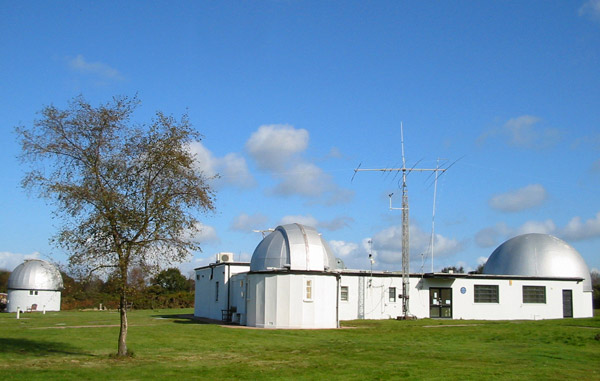
The astronomer’s discovery was decades ahead of its time. Scientists have only recently shown just how full of life the sky really is. You may see clouds and empty blue when you look up, but millions of pounds of tiny bacteria, fungi and other germs are actually floating up there — sometimes, miles above your head. Germs that cause plant disease can strike from the sky, turning an entire field of lettuce brown all at once. Some scientists believe that germs in the sky may even influence when it rains and snows.
Visitors from Venus?
In Barber’s time, however, the idea of germs raining from the sky was hard to believe. The scientist himself may have begun to doubt his findings when the microbial fallout ended a few days after it began. At once, his photographs of the night sky came out clean again. Except for when they didn’t. Eight more times in the next 24 years, an unseen storm of germs fell from the sky. And each time, they ruined photographs of starlight taken at the observatory.
Barber studied outer space, so it was only natural for him to wonder if the strange germs might be space aliens. He decided to investigate whether the movements of planets circling the sun had anything to do with the rain of germs. The answer surprised him.
The strange germs always arrived in spring or summer, a few days after two curious events. Venus, the mysterious, cloud-covered planet, always happened to be lined up so that it was between Earth and the sun. And each time, the sun had also just coughed up a strong gust of solar wind — a steady flow of tiny, charged particles. So this gust of solar wind would hit Venus on its way to Earth.
To Barber, this all added up to one thing: The falling germs must be coming from Venus!
Barber reasoned that the charged particles zooming from the sun toward Earth had first swept up germs from the heavy clouds blanketing Venus. From there, the solar wind propelled those germs through 80 million kilometers (50 million miles) of empty space between Venus and Earth. Then the microbes fluttered down, like falling leaves, into the water tank on his roof. Or so he thought.
Barber was impressed that simple living things could travel through outer space so easily. After all, humans struggled to build rockets that ventured into space for only a few hours. “Such a bacterial invasion,” he wrote in 1961, “is an infinitely more elegant way of interplanetary travel than all the marvels of modern rocketry.”
Alas, few scientists now accept Barber’s explanation. Instead, they have found that germs falling onto Earth’s surface are often carried by conventional winds from elsewhere on our planet. But Barber was right about one very important thing: Even if his germs didn’t travel through space, some of them still drifted a long way to reach his water tank!
Bumpy airplane rides
Modern-day atmospheric scientists like Kimberly Prather are working hard to document tiny germs and other, nonliving particles that invisibly float through Earth’s atmosphere. They want to know how these things might affect everything from tomorrow’s weather to global warming, the gradual heating of Earth due to increased levels of carbon dioxide in the atmosphere.
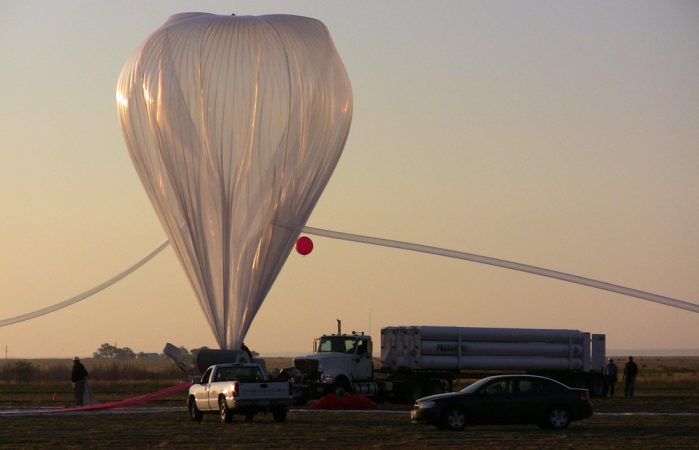
Normally, Prather works at the Scripps Institution of Oceanography in La Jolla, Calif. But over the last several years, she has also logged many hours on bumpy airplane rides in search of particles in the clouds. The plane zigzags through clouds over Montana or California, sometimes as high as 8 kilometers (about 5 miles). Hoses on the plane’s wings suck in air from the clouds and feed it into a row of machines inside the plane. Those machines taste microscopic specks floating through the air.
Prather loves her job. “Who else gets paid to fly through clouds and measure everything right in front of your eyes?” she asks.
It’s only in the last couple of years that scientists like her have been able to identify the particles blowing around in a cloud from one second to the next.
Sometimes, Prather’s machines taste bits of ash from forest fires or chimneys. Many times the devices taste dust that has traveled 9,500 kilometers (6,000 miles) from the Gobi Desert in Asia. They also taste plenty of germs.
Some of those germs probably get caught up in dust storms raking over deserts in Africa or Asia. Other germs might be lifted thousands of meters into the sky by the electric fields in thunderstorms — much like static electricity from freshly dried laundry can lift up the hair on your arms.
Prather thinks that the splish-splashing of the ocean might also fling lots of germs into the air. Last year, she conducted an experiment to find out.
Bursting bubbles
On one cool afternoon, Prather and 10 other scientists gather inside a metal warehouse at the Scripps Institution in southern California. This building houses several tanks of water (one of them big enough to drive a car through) and machines for making waves in those tanks.
Everyone gathers around a long, narrow tank with clear sides. A mechanical paddle moving back and forth inside the tank sends ripples through the seawater, generating one wave after another. It’s the kind of experiment that you probably did in the bathtub when you were younger, leading to a wet floor and an upset mom or dad. But this tub is 50 feet long!
Each wave crashes at the end of the tank in a fizz of little bubbles. Those bursting bubbles are what interest Prather. When a bubble — even a tiny one — bursts, it is an incredibly violent thing.
The rounded walls of a bubble are thinner than a hair. But as each bubble bursts, its tiny walls of water come crashing down like the walls of a collapsing building. Their falling weight pushes a tiny spurt of water straight up into the center of the bubble. And how unlucky you are if you happen to be a tiny germ floating in the wrong place at the wrong time.
Those unlucky organisms are shot into the air with a push equal to 1,000 times the force of Earth’s gravity. (If you’ve ever been on a merry-go-round and scared because you were spinning too quickly, with blood rushing to your head, you were probably feeling only two times the force of Earth’s gravity.) A bursting bubble can fling hundreds of germs into the air, ripping some of them apart in the process.
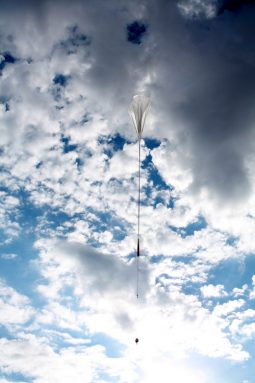
The air inside the tank doesn’t look cloudy, but it’s chock-full of sea life far too small to see. The air over the world’s oceans is probably full of tiny sea life, too.
Each day around 1,000,000,000,000,000,000,000 — or 1 billion trillion — bubbles pop in the world’s oceans. And every day, those bursting bubbles may heft thousands of pounds of germs into the air. Prather is testing this idea in the wave tank. A tube sucks air from the top of the tank, just above the water’s surface. It then feeds this air to several rows of machines like the ones she takes on her bumpy airplane rides.
Prather walks over to one of her machines — a 1.5-meter (5 foot) tall tangled mess of metal hoses and blinking lights. It click-click-clicks several times per second. With each click, it has sensed a tiny speck floating in the sucked-in air. Using a laser, that machine blasts the speck to smithereens. The machine sniffs the vaporized leftovers to see what they’re made of — the same way that you sniff the air in the kitchen to see what’s cooking. A row of jagged peaks flashes across a computer screen. Those peaks represent a list of chemical ingredients, similar to a list on a cereal box. They tell Prather what each speck was made of.
She clicks her computer’s mouse, flipping through several of these ingredient lists. In each one, two peaks rise far above all others: They indicate the presence of sodium chloride, the stuff that table salt is made from. Those peaks mean that right now, the machine is tasting flecks of sea salt flung into the air by the bubbles.
After paging through a few more lists, Prather stops at one with many more peaks. “Those are organic — that’s a critter right there,” she says. “There’s carbon. There’s your phosphorus. There’s nitrogen,” she adds, pointing out the peaks representing the fried guts of a single-celled organism.
Before this poor critter got blasted, it managed to ride a bursting bubble into the air. Lots of bacteria and other tiny ocean organisms called diatoms take a similar wild ride every day.
Rain maker
Gary Franc, a microbiologist at the University of Wyoming in Laramie, studied bacteria in the sky — in clouds, to be exact. He sampled the bacteria in tiny water droplets from clouds drifting over Mount Werner, 3,200-meters (10,500 feet) high in the Rocky Mountains of Colorado. He could tell different types of bacteria from one another by looking at the genetic material — that is, the DNA — inside their cells. His team found dozens of different types of bacteria in winter storm clouds. Those clouds may well hold thousands of different types of bacteria.
Franc, who recently died, found that one type of germ really gets around: a bacterium called Erwinia carotovora. It can cause potato plants to wilt with disease. Franc found Erwinia in the waters of the Pacific Ocean and in tiny droplets of water in the wind blowing off of the ocean. Somehow the bacterium gets from there to the potato fields of Colorado, 800 kilometers (about 500 miles) to the east.
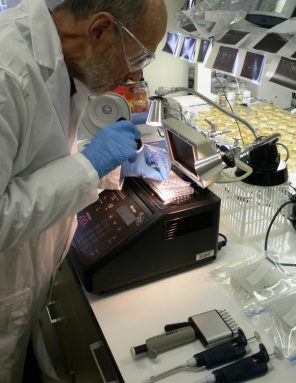
Franc believed that Erwinia somehow moves from the ocean into the air, whether by bursting bubbles or some other way. Erwinia then hitches a long-distance ride in the tiny droplets of water that make up clouds. As a droplet freezes and turns to snow, Erwinia then becomes part of a snowflake, riding it down onto the mountains. Franc found Erwinia in the snowmelt on mountaintops, and also many miles downstream in water that is used to irrigate fields of thirsty potato plants.
Franc thought those bacteria weren’t just traveling with clouds. Research by him and other people indicated that some germs actually cause the clouds to drop rain or snow. This allows the hitchhiking germ to find new crop plants to infect. “It’s a good way to get around,” he explained.
Scientists have wondered for a long time what makes clouds drop rain and snow. Recent research suggests that germs, including bacteria, are part of the answer.
Most clouds form and disappear without ever dropping any water. That may seem surprising. But not all things high in the sky fall back to Earth so easily.
Imagine a huge stack of tomato soup cans on display in a grocery store. That wobbly stack of cans could go tumbling at any moment. But it doesn’t. You have to give it a little shove to make it topple.
A dark, angry-looking cloud is sort of like that delicate stack of soup cans. That cloud is bulging with water, just waiting to dump it. A single cloud can hold 9 million kilograms (4 million pounds) of water! But all of that water is floating in tiny droplets that weigh only about a billionth of a gram each. Like little wispy feathers held up by a soft breeze, the droplets are too small to fall from the sky on their own. That water will remain aloft until something helps the droplets grow big and heavy enough to fall.
And that’s where germs come in.
Ice maker
Scientists have found that some species of bacteria, diatoms and plant pollen can help water freeze. Put those bacteria into a cloud with water droplets that are cold enough, and the droplets will freeze into tiny ice crystals. Each time a stray water molecule or another water droplet bumps into the ice crystal, the two stick together — like your wet tongue sticks to a frosty ice cube. The more moisture the ice crystals collect, the heavier they become. When they become too heavy for the atmosphere to hold up any longer, they fall.
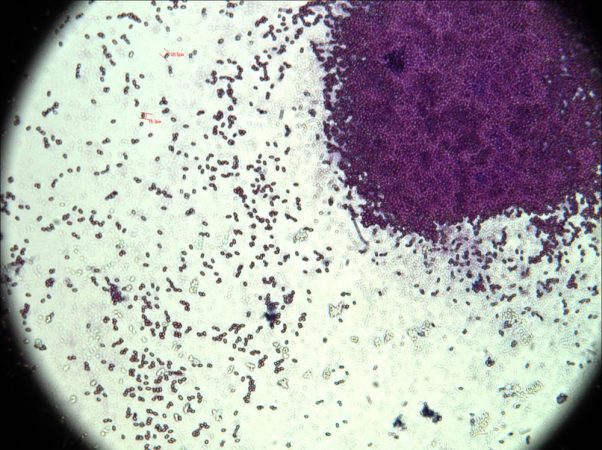
Scientists know that both rain and snow usually begin in ice-forming events in clouds. If it’s warm enough, the ice melts on the way down — delivering rain. If it stays cold, the ice remains frozen and falls as snow or hail.
Scientists wondered for 50 years what makes ice in clouds. Some said it was dust, some said it was sea salt and others said it was little bits of soot. In fact, all of those things can serve as a nucleator — the base upon which an ice crystal forms.
Scientists have tested hundreds of minerals, salts, sugars and other chemicals for their ability to cause water to turn into ice. They have also tested different types of bacteria. It turns out that some bacteria are actually far better at making ice than any of those other, nonliving things. Other living things, such as some diatoms, also can form ice.
“When it comes to forming ice, biology does it the best,” says Brent Christner, a microbiologist at Louisiana State University in Baton Rouge who studies the bacteria in clouds.
Prather has found support for the idea that cells can trigger ice formation during her flights through clouds over California, Wyoming and the Caribbean Sea. Cloud regions that have lots of ice also have lots of dust from either Africa or Asia. Much of that dust carries hitchhiking bacteria or other cells. In those icy parts of the clouds, she sees the same peaks for carbon, nitrogen and phosphorus — evidence of cells — that she saw in her wave-and-bubble experiment.
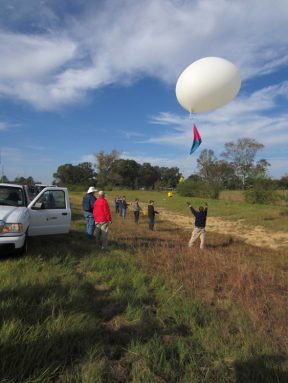
Her results suggest that microorganisms could at least sometimes influence the weather. Says Prather, “It’s hard to imagine that it’s not shifting where you have rain and where you don’t.”
Beware the breeze
It is easy to look back now and see the mistake that Barber, the astronomer, made 50 years ago. He fell into a common trap: When germs spoiled his photographs, he settled on an exciting explanation — and overlooked a simpler one. The observatory where he worked sits on a high hill, only a kilometer from the southern edge of England, where cliffs drop into the ocean. Germs that parachuted into Barber’s water tank could easily have drifted over the Atlantic Ocean on winds from North America. The observatory was in a good place to catch whatever was blown over the ocean.
But Barber wasn’t the first person to point to another planet as the source of pesky germs. In 1918, a serious outbreak of influenza (the flu) spread around the world, killing millions of people. Some people later wondered if the unusually lethal virus that caused this illness might also have come from Venus. Scientists now realize that the virus travels inside birds — not from planet to planet, but from continent to continent.
It’s easy to think how much smarter we are today than we were then. But even today, scientists studying germs in the sky have to constantly be on guard against making mistakes.
While scientists are figuring out how bacteria in the sky may affect weather, they are also finding bacteria living far higher in the atmosphere than anyone expected. Using high-altitude weather balloons, Christner has collected living bacteria up to 18 kilometers (about 11 miles) above Earth’s surface. That’s up to twice as high as a commercial jet flies.
And a rocket launched by a Russian team even seems to have brought back living bacteria from 77 kilometers (almost 48 miles) above Earth’s surface — eight times as high as the world’s highest peak, Mount Everest!
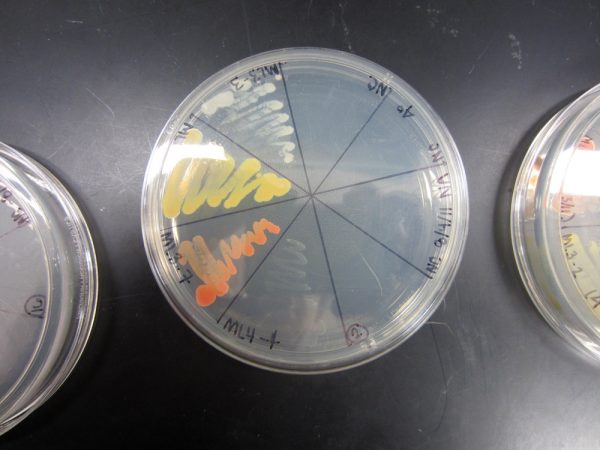
“Anything that survives there must be pretty remarkable,” says Christner. Conditions at just 30 kilometers (about 19 miles) are a lot like the surface of Mars. At such heights, the intensity of the sun’s damaging ultraviolet radiation is 1,000 times stronger than at ground level. And the thin air dries out and kills bacteria. Finding bacteria still alive up there could make people more willing to believe that tiny, single-celled life could also live on Mars.
These are exciting findings — but they also cause Christner to think of the big mistakes that scientists can sometimes make. A bacterium brought back on a rocket might have survived dozens of kilometers high in the atmosphere — or it might have just wafted into the laboratory through an open window, on a speck of dust from a dirt pile a few meters away. The same possibility will be true for any so-called alien bacteria brought back from Mars. All it takes is one cell to blow in on the air and contaminate the sample. That one cell can grow into a million, and pretty soon you think you’ve got a germ from Mars. But it’s only a local hitchhiker carried in by a breeze.
Finding out what really survives miles high in the sky and telling these organisms apart from the hitchhikers will test the limits of science. But it is important to do. Discovering germs in the sky is incredibly exciting. It is already changing our understanding of the global environment.
Power Words
astronomer A scientist who studies space, including celestial objects such as galaxies, stars and other planets.
bacteria A simple form of single-celled life that is too small to see with the naked eye. A spoonful of dirt or pond water can hold millions of bacteria.
crystal A solid substance such as table salt, ice or quartz that is made of atoms stacked together in a neat pattern.
DNA The long molecule shaped like a twisted ladder that holds the genes, or genetic material, of all living things. Organisms can be identified by their DNA.
diatoms Tiny, ocean-dwelling organisms made of up just one or a few cells. Diatoms live like plants, using sunlight to turn carbon dioxide into sugars.
droplet A drop of water that is too small to see. Clouds, fog and even steam boiling out of a pot on the stove are made of many, many water droplets floating in the air.
fungus One of the six kingdoms of life (the others include plants, animals, protists, eubacteria and archaebacteria) that includes mushrooms, mold and tiny, single-celled organisms such as yeast.
germ A general name for any tiny living thing that is too small to see, such as bacteria, some types of fungi, and protists such as amoebas and parameciums.
global warming The gradual warming of Earth caused by increased levels of carbon dioxide and other so-called greenhouse gases in the atmosphere. Carbon dioxide is released by many human activities, from the cutting down and burning of forests to the burning of fossil fuels like oil, natural gas and coal.
gravity The force that pulls things toward each other. On Earth, gravity holds you on the ground and causes a dropped apple to fall downward.
laser A concentrated beam of light. If strong and highly focused, that beam can burn through most things, including metal.
microbiologist A scientist who studies living things that are too small for the naked eye to see, such as single-celled organisms.
molecule The smallest piece of a chemical, containing only a few atoms and often measuring less than a billionth of a meter across. A molecule of water, H2O, consists of two atoms of hydrogen (H) and one atom of oxygen (O).
nucleator A tiny particle that triggers crystal formation. Crystals such as ice often do not form easily on their own, even when water is below its freezing point. But once the ice crystal nucleates, or forms, it can then grow quickly on its own.
observatory A place where optical telescopes are housed. Astronomers use these telescopes to view very distant things in space, such as planets and stars. Astronomers used to do much of their work at observatories.
organic Made of complex, carbon-based molecules that also contain other elements such as oxygen, hydrogen, nitrogen and phosphorus. Most organic things are either living or once were alive.
organism Any living thing. These range from tiny bacteria, plants and mushrooms to birds, lizards, humans and even elephants and whales.
single-celled Consisting of just one cell. Single-celled organisms are too small to see with the naked eye. They include bacteria, some kinds of fungi and protists such as the amoeba.
sodium chloride The chemical that makes up table salt — and also that makes up most of the salt in the ocean.
solar wind A steady flow of tiny charged particles that moves outward from the sun, flowing past Venus, Earth and all of the other planets.
vaporize To heat a solid enough to transform it into a gas, or vapor.
Venus A planet in our solar system. Venus is second-closest planet to the sun, between Earth (which is third-closest) and Mercury (which is the closest). Venus is very hot and covered in thick clouds.
westerly wind A wind that blows from west to east. Westerly winds blow across the Atlantic Ocean, from North America to England and the rest of Europe.
Word Find (click here to print puzzle)
